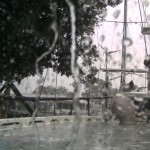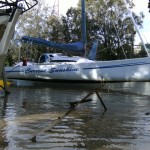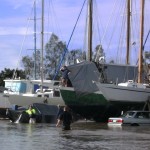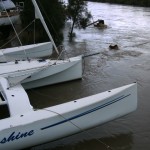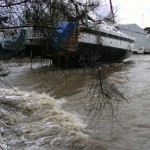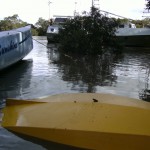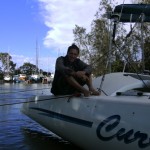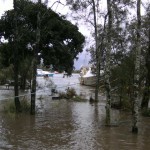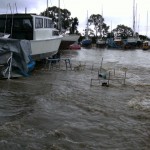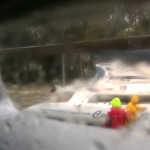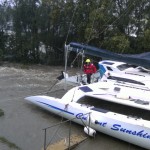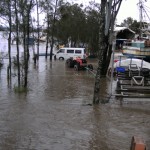Last week I was about to motor upriver to do another battery discharge test – but I found something suspicious about the motor and stripped it down to check. Water had been getting in – in very small amounts but enough to cause corrosion. This is worrying in a electric motor and is possibly the last straw for this camel. There’s been an ongoing series of problems with the Epod motor which continue to delay my sailing.
It is now two years since I ordered the Epod and still its not ready to go. To begin with it took about twelve months to take delivery of it, and now another twelve months to troubleshoot it. Of course there’ve been other boat projects to do, and other things which have caused delays, but a prime delayer has been the motor.
I’m now at a cross-roads in more ways than one. Firstly there’s whether I should even bother to persevere with this motor at all. But that is really just a practical matter which will sort itself out.
Of deeper import is what does this all mean for my life journey? So many things have conspired to delay me from sailing, from leaving this area. Is there an esoteric message here for me? I’ll ponder on it and see what comes.
—
For those who have a technical interest in my projects, read on. I’ll describe the details of the problem. But for others, take heed, techno-babble follows.
After recharging the batteries I was ready to do another discharge test last week when I checked the epod sump before going upriver. There’s a plastic tube that you suck on to see if there’s any water in the bottom of the Epod. Well, nothing happened – that is I couldn’t suck anything – the tube was blocked somehow.
So I pulled the motor out (easy enough because its on a carriage) and stripped it down again. I found aluminium corrosion in the bottom – you know that gooey gel type corrosion – and it had blocked the tube. Well, the tube did its job but in a different way to expected.
There had been water in the motor at some time but it was dry now – a little condensation around but no water laying there. The last use was in the flood about two weeks ago – and after using it I had as usual sucked on the tube but found nothing.
But some water has been getting in. Clearly not enough to even be sucked up in the tube, but enough to cause corrosion. All the electricals are fine – the brushes, commutator and armature are all above any water that got in, and are in fine condition.
I pulled off both end bells looking for the point of ingress. On the brush-end there was a drip line of corrosion showing where water had got in past the o-ring and dripped down the inside face of the end bell. At this end there was gritty dust of corrosion – a different type to the soft gel like corrosion at the otehr end. The prop end, the end with the tube, is slightly lower and the water gathered at this end.
I had pulled the ends bells off when I had a shorting out of the power cables some time ago – see a previous post about that. I expect the failure of the o-ring seal is to do with the way I put it back together. Even though I was very careful, I did reuse the o-ring – which looked perfectly fine. But I’ve now been told this is not good practise and a new o-ring should always be used.
In my search for the source of water entry I had also pulled the prop-end bearing out of the end bell. I found water here between the seal and the bearing. There was a glob of water about the size of a pea. The bearing was still ok, although stiffer than what I expected. This bearing and seal are as they came from the factory. The presence of water here is worrying and the bearing would have failed sooner or later. So in a way I was lucky to have found that problem now.
The bearing at the prop end is retained with a galavanised steel washer which is screwed to the end-bell with galvanised screws. The screws and the washer are rusted. The through boats that hold the end bells together are also rusted on the threads. Probably from moisture condensing there.
I’m concerned about the mixture of disimilar metals in the epod. The aluminium end bells have corroded and some of the steel items have corroded.
As I contemplate rebuilding the epod again I’m considering having the end bells rebuilt out of stainless steel and using stainless steel bolts and washers, and not having any aluminium at all. In this way even if moisture does get in, it won’t be harming. It’ll cost about $1000 to have the parts remade in Stainless Steel.
I’ve also checking out another electric motor from Germany and which has been available in small sizes for a while now. They’ve just released a bigger version that would suit my boat. There’s an agent here in Australia – and only an hour away from here. He’s agreed to bring a motor down to Current Sunshine later this week so we can do some tests and see how powerful it is, and how much current in draws. The downside is that its pricey – at over 6 grand its a big step for me after investing so much time and money into the other one. As well it doesn’t have regen capability.
Anyway, stay tuned and I’ll let you know how it is.

